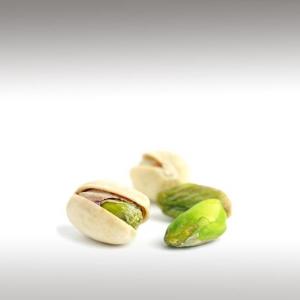
PISTACHIO OIL (PISTACIA VERA) - BASE OILS

BASE / GENERAL DATA
Information submited: June 2, 2015 Modified: May 9, 2018 By: OperaDreamhouse
The earliest records of Pistachio in English are around roughly year 1400, with the spellings “Pistace” and “Pistacia”.
The word Pistachio comes from medieval Italian Pistacchio, which is from classical Latin Pistacium, which is from ancient Greek Pistákion and Pistákē, which is generally believed to be from Middle Persian, although unattested in Middle Persian. Later in Persian, the word is attested in Persian as Pesteh. As mentioned, the tree came to the ancient Greeks from Western Asia.
The Pistachio a member of the Cashew family, is a small tree originating from Central Asia and the Middle East. Pistachio trees can be found in regions of Iran, Syria, Lebanon, Turkey, Greece, Xinjiang (China), Tunisia, Kyrgyzstan, Tajikistan, Turkmenistan, India, Egypt, Italy (Sicily), Uzbekistan, Afghanistan (especially in the provinces of Samangan and Badghis), and the United States(California).
It is indigenous to the eastern Mediterranean (Cyprus and Turkey to Israel and Syria), Central Asia (Turkmenistan, Uzbekistan, Afghanistan, Tajikistan, and Kyrgyzstan) and Xinjiang.
Pistachio is a desert plant, and is highly tolerant of saline soil. Pistachio trees are fairly hardy in the right conditions, and can survive temperatures ranging between -10 °C in winter and 48 °C in summer. They need a sunny position and well - drained soil.
The bush grows up to 10 m tall. It has deciduous pinnate leaves 10 - 20 centimeters long. The plants are dioecious, with separatemaleand female trees. The fruit is a drupe, containing an elongated seed, which is the edible portion.
The fruit has a hard, creamish exterior shell. The seed has a mauvish skin and light green flesh, with a distinctive flavor. When the fruit ripens, the shell changes from green to an autumnal yellow / red, and abruptly splits part way open. This is known as dehiscence, and happens with an audible pop.
Each Pistachio tree averages around 50 kilograms of seeds, or around 50,000, every two years.
It takes 5 - 8 years until the trees come to fruition and only after 15 years, crops are abundant. Crop rotation is very two years which means that the crop is altemately larger and smaller.
Pistachio oil is a pressed oil, extracted from the fruit of Pistacia Vera, the Pistachio nut. Compared to other Nut oils, Pistachio oil has a particularly strong flavor. Like other Nut oils, it tastes similar to the nut from which it is extracted.
Pliny the Elder writes in his Natural History that Pistachio seeds were a common food as early as 6750 BC. asserts that Pistacia, “well known among us” was one of the trees unique to Syria, and that the seed was introduced into Italy by the Roman Proconsul in Syria.
The Pistachio is one of three seeds mentioned in the Bible.
Archaeologists have found evidence from excavations at Jarmo in northeastern Iraq. The Hanging Gardens of Babylon were said to have contained Pistachio trees during the reign of King Merodach - Baladan about 700 BC.
Chemical structure:
Pistachio oil is high in Vitamin E, containing 19mg/100g. It contains 12,7% saturated fats, 53,8% monounsaturated fats, 32,7% linoleic acid, and 0,8% omega - 3 fatty acid.
Pistachio kernel oil has a very well balanced ratio of omega - 9 and omega - 6 (essential fatty acids) and is more stable than Walnut oil.
The nuts are packed with many importantB - complex groups of Vitamins such as riboflavin, niacin, thiamin, pantothenic acid, vitamin B - 6, and folates.
They are the storehouse of minerals like copper, manganese, potassium, calcium, iron, magnesium, zinc, and selenium.
100 g nuts provide 144% of daily - recommended levels of copper. Copper is an essential trace mineral that is required in neuro - transmission, metabolism, as well as red blood cell (RBC) prodution.
The word Pistachio comes from medieval Italian Pistacchio, which is from classical Latin Pistacium, which is from ancient Greek Pistákion and Pistákē, which is generally believed to be from Middle Persian, although unattested in Middle Persian. Later in Persian, the word is attested in Persian as Pesteh. As mentioned, the tree came to the ancient Greeks from Western Asia.
The Pistachio a member of the Cashew family, is a small tree originating from Central Asia and the Middle East. Pistachio trees can be found in regions of Iran, Syria, Lebanon, Turkey, Greece, Xinjiang (China), Tunisia, Kyrgyzstan, Tajikistan, Turkmenistan, India, Egypt, Italy (Sicily), Uzbekistan, Afghanistan (especially in the provinces of Samangan and Badghis), and the United States(California).
It is indigenous to the eastern Mediterranean (Cyprus and Turkey to Israel and Syria), Central Asia (Turkmenistan, Uzbekistan, Afghanistan, Tajikistan, and Kyrgyzstan) and Xinjiang.
Pistachio is a desert plant, and is highly tolerant of saline soil. Pistachio trees are fairly hardy in the right conditions, and can survive temperatures ranging between -10 °C in winter and 48 °C in summer. They need a sunny position and well - drained soil.
The bush grows up to 10 m tall. It has deciduous pinnate leaves 10 - 20 centimeters long. The plants are dioecious, with separatemaleand female trees. The fruit is a drupe, containing an elongated seed, which is the edible portion.
The fruit has a hard, creamish exterior shell. The seed has a mauvish skin and light green flesh, with a distinctive flavor. When the fruit ripens, the shell changes from green to an autumnal yellow / red, and abruptly splits part way open. This is known as dehiscence, and happens with an audible pop.
Each Pistachio tree averages around 50 kilograms of seeds, or around 50,000, every two years.
It takes 5 - 8 years until the trees come to fruition and only after 15 years, crops are abundant. Crop rotation is very two years which means that the crop is altemately larger and smaller.
Pistachio oil is a pressed oil, extracted from the fruit of Pistacia Vera, the Pistachio nut. Compared to other Nut oils, Pistachio oil has a particularly strong flavor. Like other Nut oils, it tastes similar to the nut from which it is extracted.
Pliny the Elder writes in his Natural History that Pistachio seeds were a common food as early as 6750 BC. asserts that Pistacia, “well known among us” was one of the trees unique to Syria, and that the seed was introduced into Italy by the Roman Proconsul in Syria.
The Pistachio is one of three seeds mentioned in the Bible.
Archaeologists have found evidence from excavations at Jarmo in northeastern Iraq. The Hanging Gardens of Babylon were said to have contained Pistachio trees during the reign of King Merodach - Baladan about 700 BC.
Chemical structure:
Pistachio oil is high in Vitamin E, containing 19mg/100g. It contains 12,7% saturated fats, 53,8% monounsaturated fats, 32,7% linoleic acid, and 0,8% omega - 3 fatty acid.
Pistachio kernel oil has a very well balanced ratio of omega - 9 and omega - 6 (essential fatty acids) and is more stable than Walnut oil.
The nuts are packed with many importantB - complex groups of Vitamins such as riboflavin, niacin, thiamin, pantothenic acid, vitamin B - 6, and folates.
They are the storehouse of minerals like copper, manganese, potassium, calcium, iron, magnesium, zinc, and selenium.
100 g nuts provide 144% of daily - recommended levels of copper. Copper is an essential trace mineral that is required in neuro - transmission, metabolism, as well as red blood cell (RBC) prodution.

SPIRITUAL PRACTISES DATA

MEDICINE / HEALTH DATA

BEAUTY / COSMETICS DATA

FOOD / COOKING DATA
COMMENTS
No comments.


